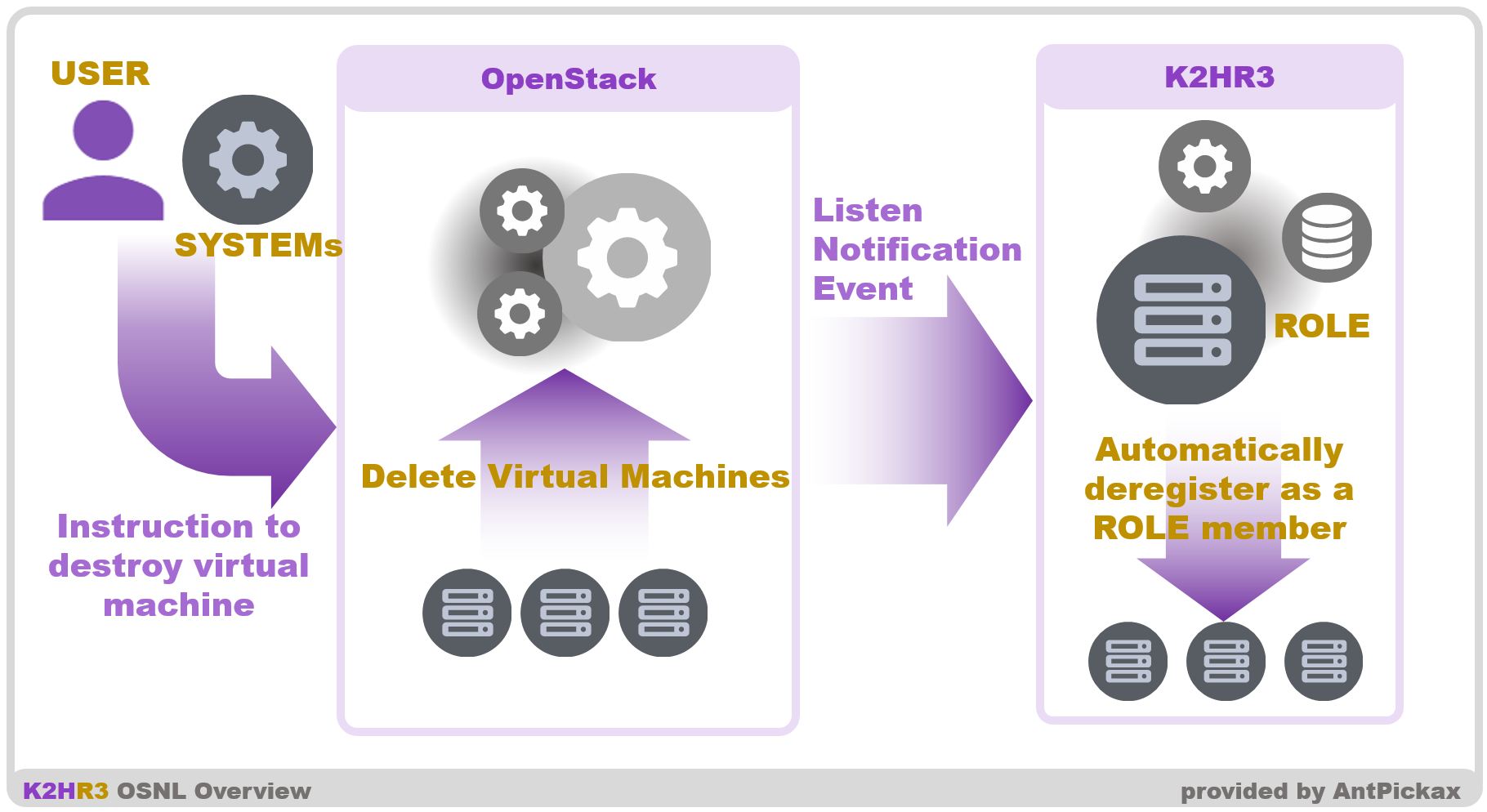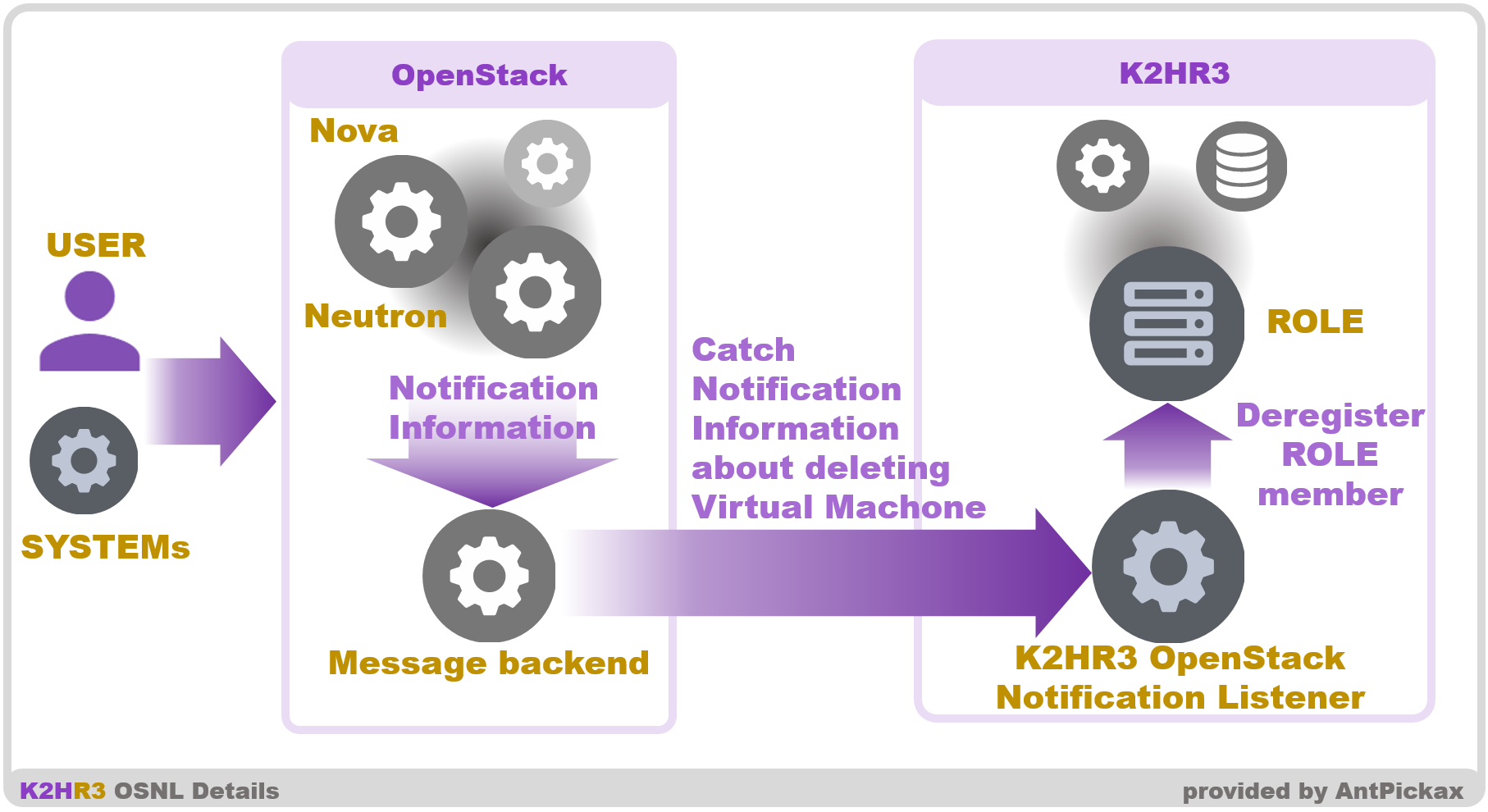Details of K2HR3 OpenStack Notification Listener
This page describes how K2HR3 OpenStack Notification Listener works in detail.
K2HR3 OpenStack Notification Listener is a daemon process to synchronize the OpenStack ‘instance’ metadata between OpenStack and K2HR3. To catch a new notification, it listens to a queue in a messaging backend where messages sent by OpenStack services are delivered.

OpenStack Notification Listener
This chapter describes the OpenStack Notification Listener behavior.
OpenStack Notification Listener listens to notification messages from OpenStack services. However, OpenStack services, notifiers, don’t directly send notification messages to OpenStack Notification Listener. Here is the general delivery flow of notification messages from notifiers to listeners.
- Notifiers emit notification messages to a messaging backend when events to be notified for the others happen.
- They use messaging drivers, which are defined by oslo.messaging, to publish notification messages.
- Notification messages are guaranteed not to be duplicated because they are sent ‘at-most-once’.
- The messaging drivers determine the each notification message format.
- The messages driver must be either the messaging or the messagingv2.
- The notifier’s configuration determines the message driver.
- They use messaging drivers, which are defined by oslo.messaging, to publish notification messages.
- Notifiers publish each message with a topic and an exchange.
- The topic is used as a routing key in a messaging backend.
- The message backend determines a queue where the message is delivered by using the topic.
- The exchange is a valid scope of the message, which can be used to restriction access to the message.
- See Environments and Settings for the listener settings of the topic and the exchange.
- The topic is used as a routing key in a messaging backend.
- A messaging backend will receive notification messages and then distribute the copies to destination queues using rules called ‘bindings’.
- Message queues are where notification messages are delivered by a messaging backend.
- The messaging backend then deliver a message to one randomly selected OpenStack Notification Listener.
- The selected OpenStack Notification Listener will parse the message by using a exposed function which corresponds to the message’s priority.
- For example, a message priority is ‘info’, the listener invoke the ‘info’ function of its own.
K2HR3 OpenStack Notification Listener
This chapter describes the ‘K2HR3 OpenStack Notification Listener’ behavior.
K2HR3 OpenStack Notification Listener is a plugin of OpenStack Notification Listener. The following figure shows the overview of the plugin, which describes that:
- It consumes messages in the message backend.
- The message contains the metadata of the deleted instance.
- It parses the message.
- The plugin finds the unique id and the IP address of the deleted instance.
- It calls the delete method of the K2HR3’s Role API with them.

Here are the primary settings parameters to control the plugin’s behavior.
- transport_url
- This parameter value represents the transport configuration parameters in the form of a URL.
- Transport URLs take the form:
- transport://user:pass@host1:port[,hostN:portN]/virtual_host
- See the oslo.messaging’s Transport for details.
- ex) rabbit://guest:guestpass@127.0.0.1:5672/
- RabbitMQ is a messaging backend.
guestis the username to login the messaging backend.guestpassis the password to login the messaging backend.localhostis the host name to login.5672is the port number of the host.
- ex) rabbit://guest:guestpass@127.0.0.1:5672/
- topic
- The parameter determines the queue name to be delivered the notification messages to.
- It is used as a routing key in a messaging backend.
- This parameter is required when each OpenStack service publishes notification messages.
- notifications is the default value in K2HR3.
- The messaging priority will be added at the end of the topic name to the actual queue name.
- The parameter determines the queue name to be delivered the notification messages to.
- exchange
- This parameter determines a valid scope of a notification message.
- neutron is the default value in K2HR3.
To know how to configure the plugin, see the Environments and Settings page.
To parse messages and find enough information to call the K2HR3’s [Role API](api_role.html], the values of the ‘topic’ and the ‘exchange’ must be configured with the same with notifiers target destination settings. See the Environments and Settings page for the plugin settings.
Detail Various